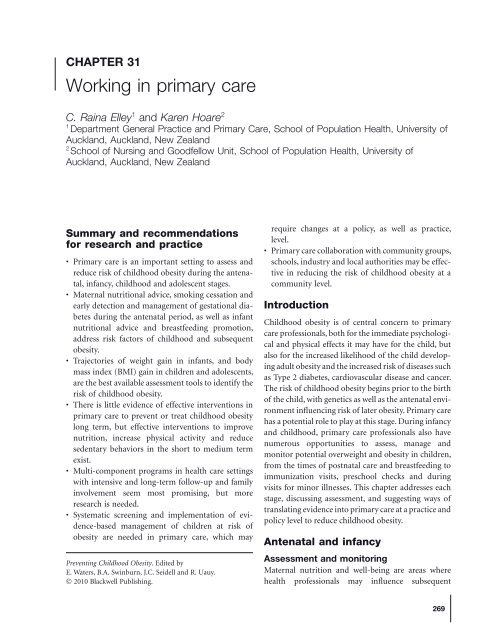Preventing Childhood Obesity - Evidence Policy and Practice.pdf
Preventing Childhood Obesity - Evidence Policy and Practice.pdf
Preventing Childhood Obesity - Evidence Policy and Practice.pdf
You also want an ePaper? Increase the reach of your titles
YUMPU automatically turns print PDFs into web optimized ePapers that Google loves.
CHAPTER 31<br />
Working in p rimary c are<br />
C. Raina Elley 1 <strong>and</strong> Karen Hoare 2<br />
1 Department General <strong>Practice</strong> <strong>and</strong> Primary Care, School of Population Health, University of<br />
Auckl<strong>and</strong>, Auckl<strong>and</strong>, New Zeal<strong>and</strong><br />
2 School of Nursing <strong>and</strong> Goodfellow Unit, School of Population Health, University of<br />
Auckl<strong>and</strong>, Auckl<strong>and</strong>, New Zeal<strong>and</strong><br />
Summary <strong>and</strong> recommendations<br />
for research <strong>and</strong> practice<br />
• Primary care is an important setting to assess <strong>and</strong><br />
reduce risk of childhood obesity during the antenatal,<br />
infancy, childhood <strong>and</strong> adolescent stages.<br />
• Maternal nutritional advice, smoking cessation <strong>and</strong><br />
early detection <strong>and</strong> management of gestational diabetes<br />
during the antenatal period, as well as infant<br />
nutritional advice <strong>and</strong> breastfeeding promotion,<br />
address risk factors of childhood <strong>and</strong> subsequent<br />
obesity.<br />
• Trajectories of weight gain in infants, <strong>and</strong> body<br />
mass index ( BMI ) gain in children <strong>and</strong> adolescents,<br />
are the best available assessment tools to identify the<br />
risk of childhood obesity.<br />
• There is little evidence of effective interventions in<br />
primary care to prevent or treat childhood obesity<br />
long term, but effective interventions to improve<br />
nutrition, increase physical activity <strong>and</strong> reduce<br />
sedentary behaviors in the short to medium term<br />
exist.<br />
• Multi - component programs in health care settings<br />
with intensive <strong>and</strong> long - term follow - up <strong>and</strong> family<br />
involvement seem most promising, but more<br />
research is needed.<br />
• Systematic screening <strong>and</strong> implementation of evidence<br />
- based management of children at risk of<br />
obesity are needed in primary care, which may<br />
<strong>Preventing</strong> <strong>Childhood</strong> <strong>Obesity</strong>. Edited by<br />
E. Waters, B.A. Swinburn, J.C. Seidell <strong>and</strong> R. Uauy.<br />
© 2010 Blackwell Publishing.<br />
require changes at a policy, as well as practice,<br />
level.<br />
• Primary care collaboration with community groups,<br />
schools, industry <strong>and</strong> local authorities may be effective<br />
in reducing the risk of childhood obesity at a<br />
community level.<br />
Introduction<br />
<strong>Childhood</strong> obesity is of central concern to primary<br />
care professionals, both for the immediate psychological<br />
<strong>and</strong> physical effects it may have for the child, but<br />
also for the increased likelihood of the child developing<br />
adult obesity <strong>and</strong> the increased risk of diseases such<br />
as Type 2 diabetes, cardiovascular disease <strong>and</strong> cancer.<br />
The risk of childhood obesity begins prior to the birth<br />
of the child, with genetics as well as the antenatal environment<br />
influencing risk of later obesity. Primary care<br />
has a potential role to play at this stage. During infancy<br />
<strong>and</strong> childhood, primary care professionals also have<br />
numerous opportunities to assess, manage <strong>and</strong><br />
monitor potential overweight <strong>and</strong> obesity in children,<br />
from the times of postnatal care <strong>and</strong> breastfeeding to<br />
immunization visits, preschool checks <strong>and</strong> during<br />
visits for minor illnesses. This chapter addresses each<br />
stage, discussing assessment, <strong>and</strong> suggesting ways of<br />
translating evidence into primary care at a practice <strong>and</strong><br />
policy level to reduce childhood obesity.<br />
Antenatal <strong>and</strong> i nfancy<br />
Assessment <strong>and</strong> m onitoring<br />
Maternal nutrition <strong>and</strong> well - being are areas where<br />
health professionals may influence subsequent<br />
269

















